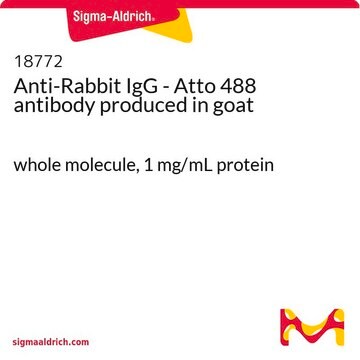F7512
Anti-Rabbit IgG (whole molecule)−FITC antibody produced in sheep
affinity isolated antibody, buffered aqueous solution
Synonym(s):
Sheep Anti-Rabbit IgG (whole molecule)−Fluorescein isothiocyanate
About This Item
Recommended Products
biological source
sheep
conjugate
FITC conjugate
antibody form
affinity isolated antibody
antibody product type
secondary antibodies
clone
polyclonal
form
buffered aqueous solution
storage condition
protect from light
technique(s)
direct immunofluorescence: 1:160
immunohistochemistry (formalin-fixed, paraffin-embedded sections): 1:160
storage temp.
−20°C
target post-translational modification
unmodified
Related Categories
General description
Fluorescein isothiocyanate (FITC) is a fluorescein derivative (fluorochrome) used to tag antibodies, including secondary antibodies, for use in fluorescence-based assays and procedures. FITC excites at 495 nm and emits at 521 nm.
Application
- immunocytochemistry
- immunofluorescence
- immunohistochemistry
Other Notes
Physical form
Disclaimer
Not finding the right product?
Try our Product Selector Tool.
Storage Class Code
12 - Non Combustible Liquids
WGK
WGK 2
Flash Point(F)
Not applicable
Flash Point(C)
Not applicable
Personal Protective Equipment
Certificates of Analysis (COA)
Search for Certificates of Analysis (COA) by entering the products Lot/Batch Number. Lot and Batch Numbers can be found on a product’s label following the words ‘Lot’ or ‘Batch’.
Already Own This Product?
Find documentation for the products that you have recently purchased in the Document Library.
Customers Also Viewed
Our team of scientists has experience in all areas of research including Life Science, Material Science, Chemical Synthesis, Chromatography, Analytical and many others.
Contact Technical Service












